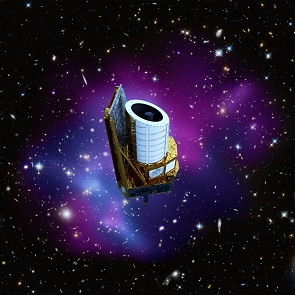Science
 |
| Artist's impression of Euclid. Credit: ESA/ATG medialab (spacecraft); NASA, ESA, CXC, C. Ma, H. Ebeling and E. Barrett (University of Hawaii/IfA), et al. and STScI (background) |
Euclid is an ESA mission that will fly an extremely sophisticated space telescope to measure the shapes of more than a billion galaxies, and accurate redshifts of tens of millions of galaxies.
The data are used to determine the expansion of the universe and the evolution of cosmic structures during the past 10 billion years of cosmic history with an unprecedented accuracy.
This will allow astronomers to map the geometry of the Universe and better understand the mysterious dark matter and dark energy, which are the principal components of the Universe.
The Euclid space mission puts Europe in a leading position to address these most fascinating of cosmological questions. And since the identity of the dark energy responsible for the acceleration is entirely mysterious, Euclid's answers could revolutionise physics.
| Read more |
| 1: Mission science |
| 2: What is dark matter? |
| 3: What is dark energy? |
| 4: What is gravitational lensing? |
| 5: What are baryonic acoustic oscillations? |
| 6: Legacy science (beyond cosmology) |
